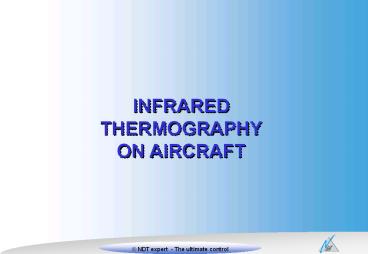Pr - PowerPoint PPT Presentation
Title:
Pr
Description:
Pulse method reflexion inspection on part M88. 7 defects visible ... Method : reflexion heating, rubber side. Frequency : 0.006 Hz. Modulation : 1000 images ... – PowerPoint PPT presentation
Number of Views:44
Avg rating:3.0/5.0
Title: Pr
1
INFRARED THERMOGRAPHY ON AIRCRAFT
2
Basic kit for the IRT control
Measurement chain
INSTRUMENTATION
1- IR camera 2 control panel of the camera 3
Direct view on the screen 4 Signal processing
of the acquisition
3
Instrumentation used in IRT
Choice of the camera
- Multiple use of the detector IR night vision,
thermal control of active sources, military
application, .
- Thermal sensitivity (0,1 till 0,01C)
- Acquisition frequency (25 till 300 image/s)
- Line acquisition mode or Focal Plane Array (FPA)
4
Instrumentation used in IRT
Heating choices
- Different techniques hot air blower, tubes,
flash lamps, hot water, pulsed heating, laser,
sun for space shuttle, heating blanckets
- Surface heating or linear heating
- Homogeneity, reproductibility, calibration,
characterization
5
IRT CONTROL ON COMPOSITE
transmission technique
14 mm
6
IRT CONTROL ON COMPOSITE
Reflexion technique
Emitted Heat Reflected Heat Absorbed Heat
7
Temperature variation in a point
Reflexion technique
With defect (isolation)
Transmission technique
time
8
Thermographic Inspection
Advantages of the method
- Global examination of part
- Only ONE SIDE access is required for the
examination
- Real Time inspection
- Apply for all composite structure and materials
even porous
- not very sensitive to part geometry, well suited
for large surfaces
Disavantages
- Sensitive to heating mode (type,duration,position
)
- Response time must be studied
- Exact composition of the pieces and the
thicknesses must be known
- Less definition than Ultrasonic C-Scan and
Radiography
- Inhomogeneous heating on complex part
9
DEFECTS ENCOUNTERED
- Lack of adhesion of cohesion, bubbles
- Delamination
- Defects on surface coatings
- Inclusions of foreign materials
- Liquid ingress
10
Pulse heating method
Detection of defects inside a honeycomb composite
part
Reflexion method Heating pulse 0.1 sec
11
Pulse method reflexion inspection on part M88
1
2
- 7 defects visible
- Contrast is decreasing after optimum image
Picture of part
First image
Heated part at T0
3
4
5
10 sec after
Optimum image
5 Sec after
12
Transmission Vs Reflexion method
Reflexion face 1
Transmission face 1 Defects seen as dark spots
- 7 defects are detected
Reflexion face 2
13
Modulated thermography
rubber
370 mm
carbon
440 mm
14 mm
Test sample, composite bonding Carbon/Elastomer
14
Modulated thermography
Phase Image
Amplitude image
Method reflexion heating, rubber side Frequency
0.006 Hz Modulation 1000 images
15
Modulated thermography
Amplitude image
Phase image
Method transmission heating, rubber
side Frequency 0.003 Hz Modulation 1000 images
16
Modulated thermography
Cross section AA
aluminium
A
A
bonding
kevlar
rubber
Disbonded area
Test sample, composite bonding Metal/Elastomer/Kev
lar
17
Modulated thermography
Amplitude Image
Phase image
Method transmission heating, kevlar
side Frequency 0.006 Hz Modulation 3000 images
18
Conclusions
- Global method, quick, well suited for detection
on composite and complex shaped surface, and for
large areas - Easy to set up on site (maintenance, expertise,
production control) - Quick evolution of the technology, lower price
of detectors, new powerfull software for analysis
tools will increase - maximum inspected thickness
- spatial and thermal resolution
- velocity of inspection































